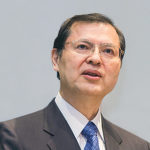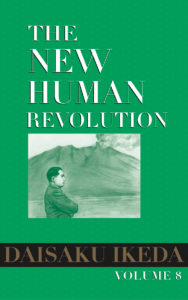 In May 1963, which marked the third anniversary of Shin’ichi Yamamoto’s inauguration as president of the Soka Gakkai, new headquarters were formed in the Chubu and Hyogo regions. These two new headquarters brought the total to 20, with 87 general chapters and 463 chapters. In September of the same year, the new Soka Gakkai Headquarters building was completed in Shinanomachi, Tokyo. It was a time when the Soka Gakkai was undergoing dynamic development both in terms of its organization and facilities.
In May 1963, which marked the third anniversary of Shin’ichi Yamamoto’s inauguration as president of the Soka Gakkai, new headquarters were formed in the Chubu and Hyogo regions. These two new headquarters brought the total to 20, with 87 general chapters and 463 chapters. In September of the same year, the new Soka Gakkai Headquarters building was completed in Shinanomachi, Tokyo. It was a time when the Soka Gakkai was undergoing dynamic development both in terms of its organization and facilities.
In the first chapter of volume 8 of The New Human Revolution, “Securing the Foundation,” Shin’ichi keenly feels that he must build a solid foundation for worldwide kosen-rufu during his lifetime, not wanting to miss this golden opportunity to spread Nichiren Buddhism. Based on his determination to preserve for all eternity the spirit of his predecessors—first and second Soka Gakkai Presidents Makiguchi and Toda—who even in the face of harsh persecution dedicated their lives to achieving peace and happiness for all humankind, Shin’ichi strives tirelessly to build a strong line-up of leaders whose hearts are overflowing with the Soka Gakkai spirit. In each region across Japan, he therefore urges the leaders to awaken to their mission and sense of responsibility for kosen-rufu, and inspires a fresh determination in the heart of each member.
On one occasion, in a meeting with some Soka Gakkai directors, Shin’ichi recalls his mentor’s guidance: “Mr. Toda was stressing the importance of self-improvement for himself as well as other leaders. This is his legacy to us.”[1] While expressing his own struggle of challenging himself to strive for personal growth, Shin’ichi also calls on the directors to share in this commitment.
In a discussion with some leaders in Hyogo Prefecture, he stresses the importance of creating unity:
The Soka Gakkai’s membership is made up of young and old alike. The true power of the Gakkai can only be revealed when each member is able to utilize his or her full potential and all can work together in harmony and unity.[2]
Later, during a visit to Amami Oshima, a remote island off the coast of Kyushu, he talks about the obstacles that might prevent the achievement of kosen-rufu. He concludes that the key issue “is not the harshness of our circumstances or our environment, but the complacency of leaders and their willingness to give up.” He also discusses the correct attitude for a leader, pointing out that “leader” is another way of saying “those who are responsible for kosen-rufu.”[3]
In the “Jeweled Sword” chapter, Shin’ichi pours his heart and soul into fostering young people, whom he regards as the “jeweled sword” in the endeavor for kosen-rufu. At a young men’s training session, one youth laments that there are only a handful of young men’s division members in his area and that the situation is very tough, to which Shin’ichi immediately replies: “You need to rise to action! … Youth have to stand alone! Then, everything will change.”[4]
After sharing with the young men his own experience from the February Campaign in 1952,[5] Shin’ichi calls on them: “I want you to stand up! You have to rise to action! I’ll be watching!”[6] He seeks to instill in them an understanding that the mentor’s fearlessness in the face of obstacles and persecution lies in the stand-alone spirit.
Doubt-free Faith
On July 1, 1963, Shin’ichi attends a young men’s leaders meeting in Tokyo, at which he announces that the seventh memorial (sixth anniversary) of Josei Toda’s death, which would be marked in April the following year, would be the start of the “essential phase” of the Soka Gakkai’s development. This refers to the time when kosen-rufu is realized in actuality, not in concept or theory—a time when every area of human endeavor, including education, art, government and finance, will be brought to full bloom. And it is the age in which disciples spread their wings and take flight toward the realization of kosen-rufu.
Shin’ichi explains that the key to achieving victory in the essential phase is to believe in the Gohonzon with doubt-free faith that flows like a pure stream no matter what happens, and to ensure that the Soka Gakkai always remains an organization of pure, unsullied faith.
The “Pure Stream” chapter defines the true nature of devilish functions through a discussion of the deeds of people who had taken advantage of the organization or its members for personal ends and abandoned their faith. Such individuals often paint the Soka Gakkai and Shin’ichi himself as “great evils,” and describe themselves as victims battling for truth and justice. Such is the working of “evil demons taking possession of others.”[7]
Devilish forces seek to sow discord among practitioners and cause trouble in the organization dedicated to kosen-rufu. The reactions to the false rumors spread by those who had abandoned their faith are a reflection of each individual’s state of being, their character and their views of humanity. Therefore, it is vital for us to see through and recognize the true nature of devilish functions.
This chapter also describes the pitiful consequences faced by those who had abandoned their faith. Let us all engrave in our hearts the following solemn passage:
The offense of inciting discord within the Soka Gakkai, the organization that acts in complete accord with the Buddha’s intent and decree, and turning against it, is extremely profound.[8]
In the “Great Mountain” chapter of volume 30 of The New Human Revolution, SGI President Ikeda introduces President Toda’s words:
In this Latter Day of the Law, the Soka Gakkai has spread the Mystic Law to so many people and helped them become happy that in the Buddhist scriptures of the future, the name of our organization is sure to be recorded as “Soka Gakkai Buddha.”[9]
In the same chapter, President Ikeda writes, “Since the Soka Gakkai is ‘Soka Gakkai Buddha,’ it must continue to fulfill the great mission of kosen-rufu by creating an eternal flow of successors.”[10]
Kosen-rufu is a ceaseless and ongoing struggle between the Buddha and devilish functions. Let us therefore carry out pure faith no matter what storms of obstacles and devilish forces assail us.
A Colorful Bridge of Friendship
The “Raging Rapids” chapter recounts the events of 1964, the inaugural year of the essential phase, when the members in South Korea start to experience serious obstacles in the course of kosen-rufu.
At the beginning of January, South Korean newspapers suddenly begin to publish articles critical of the Soka Gakkai. From there, harsh social circumstances beset the kosen-rufu movement in South Korea. However, the South Korean members steadfastly carry out their Buddhist practice, firmly believing that the day will come when they can freely take part in Soka Gakkai activities. Each member works hard to become a model citizen and expand a network of trust through voluntarily striving for the betterment of their communities.
Shin’ichi chants Nam-myoho-renge-kyo every day for the members in South Korea, and works tirelessly to build a bridge of friendship and trust between South Korea and Japan through the promotion of cultural and educational exchanges.
More than 30 years later, in May 1998, Shin’ichi receives an honorary doctorate of philosophy from Kyung Hee University, South Korea, and on May 18, he makes his first visit to the SGI-South Korea Headquarters. The “Raging Rapids” chapter concludes with this scene, which signals the triumph of the South Korean members.
The serialization in the Seikyo Shimbun of the “Raging Rapids” chapter chronicling the history of the kosen-rufu movement in South Korea started on July 17, 1998. This was the anniversary of the Osaka Rally in 1957,11 at which President Ikeda, with an unyielding and invincible spirit, cried out: “Those who strive tenaciously in faith will definitely emerge victorious!”
In May 1999, President Ikeda traveled from Fukuoka, Japan, to Jeju Island in South Korea, and was bestowed an honorary doctorate of Korean language and literature from Jeju National University. On this occasion, he conducted a dialogue with President Cho Moon Boo of Jeju National University through which he further expanded the network of peace. He also wholeheartedly encouraged the members on Jeju Island at commemorative photo sessions.
Earlier this month (May 2019), in conjunction with Soka University, Jeju National University held a symposium commemorating the 20th anniversary of the conferral of this honorary doctorate. Today, the bridge of friendship between South Korea and Japan that President Ikeda forged is growing ever more splendid.
Translated from the May 29, 2019, issue of the Seikyo Shimbun, the Soka Gakkai’s daily newspaper.
Summary of Contents
 Securing the Foundation
Securing the Foundation
Shin’ichi Yamamoto combats bureaucratic tendencies within the organization. He visits Amami, one of Japan’s remote islands, laying the foundation for the development of kosen-rufu.
Jeweled Sword
Shin’ichi declares that the Soka Gakkai will enter its “essential phase” in April 1964, on the occasion of the seventh memorial (sixth anniversary) of second Soka Gakkai President Josei Toda’s passing. He focuses on training the youth, launching a series of lectures for Kyoto University student division members on “The One Hundred and Six Comparisons.”
Pure Stream
A scandal involving some Soka Gakkai leaders brings to light the true nature of devilish functions working to obstruct the organization committed to kosen-rufu.
Raging Rapids
The world is shaken by the news of U.S. President John F. Kennedy’s assassination. The members in South Korea weather persecution from the authorities, resolute in the conviction that winter always turns to spring.
This book is available at https://bookstore.sgi-usa.org.
References
- The New Human Revolution, vol. 8, p. 23. ↩︎
- Ibid., p. 37. ↩︎
- Ibid., pp. 76–77. ↩︎
- Ibid., p. 101. ↩︎
- February Campaign: In February 1952, President Ikeda, then an adviser to Tokyo’s Kamata Chapter, initiated a dynamic propagation campaign. Together with the Kamata members, he broke through the previous monthly record of some 100 new households by introducing Nichiren Buddhism to 201 new households. ↩︎
- The New Human Revolution, vol. 8, p. 102. ↩︎
- Ibid., p. 251. ↩︎
- Ibid., p. 252. ↩︎
- Ibid., vol. 30, p. 89. ↩︎
- Ibid., p. 91. ↩︎
You are reading {{ meterCount }} of {{ meterMax }} free premium articles

